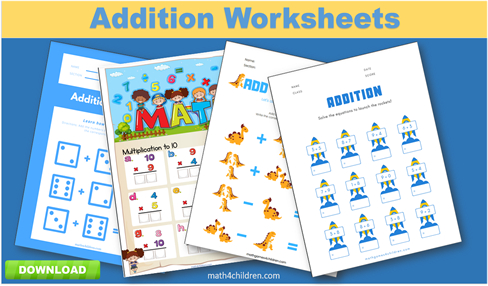![]()
Math worksheets kindergarten addition
- Basic addition using toys worksheet for kindergarten
- Addition of single digit numbers up to ten worksheet
- Addition up to ten with the aid of pictures worksheet pdf
- Addition with rockets theme worksheet for kindergarten
- Addition of two numbers with pictures worksheet
- Addition with dinosaurs worksheet for kinder
- Addition of soft balls worksheet test for review
- Addition with dice faces worksheet for kindergarten
- Addition expressions illustrated with shapes sheet
- Addition with pictures worksheet for kindergarten

Math worksheets are an important tool for helping young children learn basic math concepts and skills. In kindergarten, children are introduced to addition, which is the process of combining two or more quantities to find their sum. Addition is a crucial math skill that lays the foundation for more advanced math concepts in the future, and math worksheets can be a great way to practice and reinforce this skill.
One of the benefits of using math worksheets for kindergarten addition is that they provide a structured way for children to practice and learn. Children can work through the problems at their own pace, and parents or teachers can easily monitor their progress. Additionally, math worksheets can be customized to meet the needs of individual children, so they can be tailored to each child's unique learning style and ability level.
There are many different types of math worksheets for kindergarten addition, and it's important to choose ones that are appropriate for the age and ability level of the child. Some math worksheets may be too difficult for very young children, while others may be too easy and not provide enough of a challenge. It's a good idea to start with simple worksheets that focus on basic addition concepts, such as counting and adding single-digit numbers. As children become more comfortable with these concepts, they can move on to more advanced worksheets that involve adding larger numbers and solving word problems.
Here are some tips for using math worksheets effectively with kindergarten students:
-
Start with simple worksheets that focus on basic addition concepts. Children should be able to count and add single-digit numbers before moving on to more advanced worksheets.
-
Use a variety of worksheets that focus on different skills and concepts. This can help keep children engaged and prevent boredom.
-
Encourage children to use manipulatives, such as counting bears or blocks, to help them understand addition concepts and solve problems.
-
Use math worksheets as a supplement to hands-on math activities and real-life situations. Children should have the opportunity to practice math skills in a variety of contexts to help them understand how math is used in the real world.
-
Provide plenty of positive reinforcement and encouragement. Children should feel confident and successful when working on math worksheets, and it's important to praise their effort and progress.
Here are some examples of math worksheets for kindergarten addition:
-
Counting and adding single-digit numbers: These worksheets may involve counting objects, such as stickers or blocks, and then writing the number that represents the total quantity. Children may also be asked to add two single-digit numbers and write the sum.
-
Adding larger numbers: As children become more comfortable with basic addition concepts, they can move on to worksheets that involve adding larger numbers. These worksheets may involve carrying over when one number is larger than the other, or solving word problems that involve addition.
-
Adding and subtracting within 10: These worksheets may involve adding and subtracting single-digit numbers within 10. Children may be asked to solve problems such as "3 + 5 = ?" or "7 - 4 = ?".
-
Adding and subtracting within 20: These worksheets may involve adding and subtracting single-digit and double-digit numbers within 20. Children may be asked to solve problems such as "13 + 8 = ?" or "19 - 10 = ?".
-
Solving word problems: These worksheets involve reading and solving math problems that are presented in a story format. Children may be asked to add or subtract quantities to find the solution to the problem.
Tips For Teaching Kindergarteners Addition
Here are some tips for teaching kindergarteners addition:
-
Start with concrete objects: It can be helpful to start by using physical objects to show addition. For example, you can use blocks or counting bears to demonstrate adding two quantities together.
-
Use visual aids: Visual aids, such as number lines or ten frames, can help kindergartners understand addition. These tools can help them see the relationship between numbers and the concept of adding.
-
Use repetition: Repetition is key when it comes to helping kindergartners learn new concepts. Practice addition with your students regularly to help them build their skills and understanding.
-
Encourage hands-on learning: Kindergartners learn best through hands-on, interactive activities. Encourage them to explore and play with manipulatives, such as counting bears or blocks, as they work on their addition skills.
-
Make it fun: Make math fun by incorporating games and activities that involve addition. For example, you can play "I Have, Who Has" with addition cards or create a scavenger hunt that involves finding and adding up objects around the room.
Remember to be patient and keep the learning environment positive. It's important to praise your students for their efforts and progress, even if they don't get every problem right. With consistent practice and positive reinforcement, your students will soon be proficient in addition.
